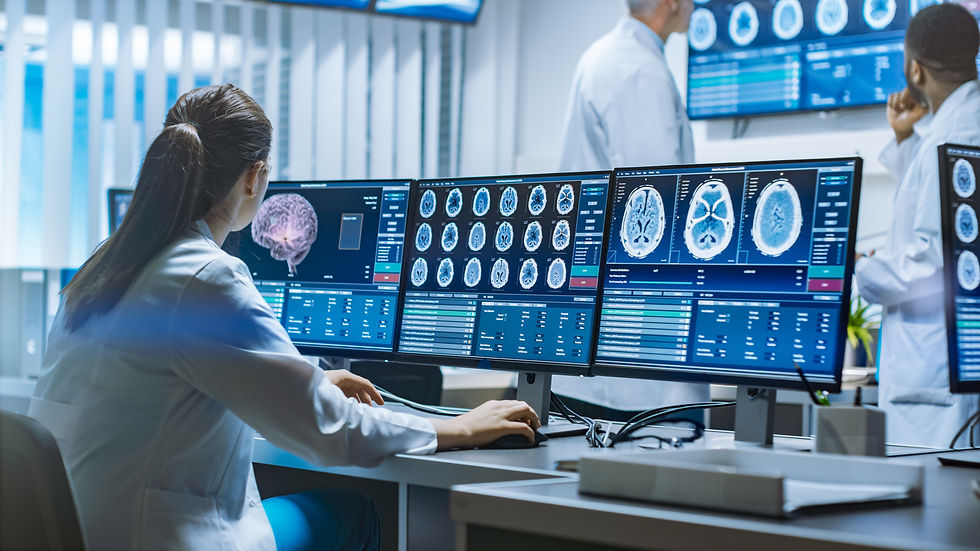The Neuroscience of Lucid Dreaming: What Happens in the Brain During a Lucid Dream?
- The Lucid Guide

- Dec 22, 2022
- 3 min read
Updated: Jan 14, 2023
Lucid dreaming is the ability to be awake and aware inside a dream, to know that you are dreaming while dreaming. It's a fascinating state with widespread appeal.

Many people have had a lucid dream at some point in their life, and it is particularly common among children and teens. But the underlying neuroscience of lucid dreaming remains mostly a mystery.
Today we'll take a dive into the latest research that explores the activity in the brain during conscious dreaming, and discover what this tells us about the nature of lucidity.
We'll also ask what this data can tell us about the brain and the nature of consciousness.
What is a Lucid Dream?
Before diving into the neuroscience of lucid dreaming, it is important to define exactly what we mean by this term.

A lucid dream is a type of dream in which the dreamer is aware that they are dreaming, has critical cognitive functions similar to wakefulness, and can often exert some degree of control over the dream's content and direction.
This awareness and control can vary widely from one lucid dream to another, and some people may only have a few lucid dreams in their lifetime while others may experience them frequently.
While the experience of lucid dreaming has been recorded throughout history, it was not until the 20th century that it was named and scientific studies began to systematically investigate this phenomenon.

One of the first studies of lucid dreaming was conducted by Marquis d'Hervey de Saint-Denys in his 1867 book Les Rêves Et Les Moyens de Les Diriger (dreams and the means to direct them), in which he kept a detailed dream diary which unexpectedly led to regular lucid dreams.
However, it was not until the 12th April 1975 that scientist Dr Keith Hearne was able to scientifically verify lucid dreams in a laboratory setting.
Since then, advances in brain imaging technology have allowed researchers to study the neural basis of lucid dreaming in greater detail.
But what do we know about brain activity during lucid dreaming and what does it tell us about the nature of this experience?
Brain Activity During Lucid Dreaming
Recent neuroimaging studies have revealed a number of intriguing findings about the brain activity during lucid dreaming.

One study using functional magnetic resonance imaging (fMRI) found that during lucid dreaming, the brain's frontal and prefrontal regions, which are associated with higher-level cognition and self-awareness, showed increased activity. This finding is consistent with the idea that lucid dreaming involves a heightened level of self-awareness and cognitive control compared to non-lucid dreaming.
Another study using electroencephalography (EEG) found that the brain activity during lucid dreaming resembles the brain activity during wakefulness in some ways, but also differs in important ways. For example, during lucid dreaming, there is increased activity in the gamma band of the EEG, which is associated with higher levels of consciousness and alertness. However, there is also decreased activity in the alpha and theta bands, which are associated with relaxation and sleep.

These and other studies suggest that during lucid dreaming, the brain is in a unique state that combines elements of both wakefulness and sleep.
This hybrid state may explain why people are able to maintain a high level of self-awareness and cognitive control while also experiencing the vivid and often surreal imagery characteristic of dreams.
Research into the neuroscience of lucid dreaming is still very much in its infancy, and therefore very few firm conclusions can be drawn. It is important to remember that lucid dreaming is a psychological frontier for which there are few firm answers.
Implications for Understanding Consciousness and the Brain
The study of lucid dreaming has the potential to shed light on some of the fundamental mysteries of consciousness and the brain. For example, the fact that people are able to maintain a high level of self-awareness and cognitive control during lucid dreaming suggests that these functions may be relatively independent of the specific brain state (i.e., wakefulness or sleep).

This finding challenges the traditional view that consciousness is closely tied to the brain's physical state and may help to explain how consciousness can persist even during sleep or other altered states of consciousness.
In addition, the study of lucid dreaming may help to illuminate the nature of the boundary between wakefulness and sleep and the mechanisms that govern the transitions between these states. Understanding these mechanisms may have practical implications for improving sleep quality and addressing sleep-related disorders.
Unravelling the Mysteries of Consciousness
The neuroscience of lucid dreaming is an active and rapidly evolving field of research that is yielding new insights into the nature of consciousness and the brain.

While much remains to be learned, the study of lucid dreaming has the potential to deepen our understanding of the complex and mysterious relationship between the brain and consciousness.
Learn more about the science and skills of lucid dreaming with the lucid dreaming guidebook Are You Dreaming?: Exploring Lucid Dreams: A Comprehensive Guide.



